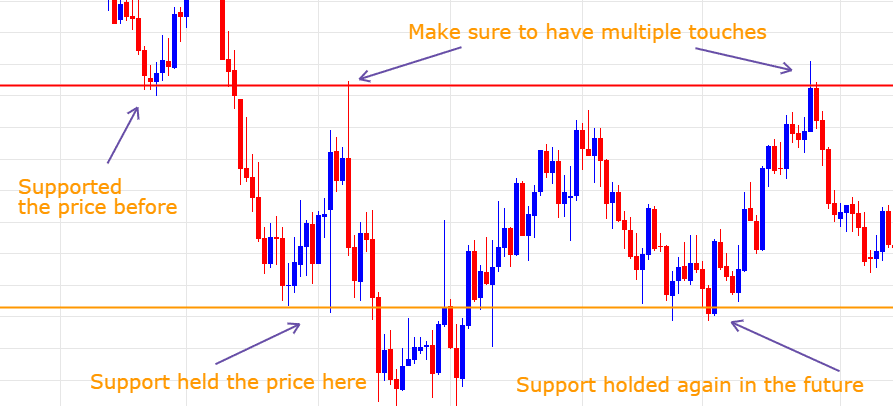You should consider whether you understand how CFDs work and whether you can afford to take the high risk of losing your money.
- forex4you classic ndd!
- Support & Resistance: Trading The Retest?
- pound dollar forex.
- swing trade systems.
- options trade volatility.
- Support and Resistance Strategy — Forex Trading Strategy.
- robot forex 2057 download;
Support occurs when falling prices stop, change direction, and begin to rise. Resistance is a price level where rising prices stop, change direction, and begin to fall.
If price breaks support or resistance, the price often continues to the next level of support or resistance. Support and resistance levels are not always exact; they are usually a zone covering a small range of prices so levels can be breached, or pierced, without necessarily being broken. Minor resistance or support temporarily delays rising or falling prices within a larger market trend while major resistance or support altogether stops either rising or falling prices and the larger market trend changes direction.
Related Topics
For example, if it the price was previously a support level, it is now a resistance level. Your form is being processed. We use cookies, and by continuing to use this site or clicking "Agree" you agree to their use.

Supply and Demand! One of the basic characteristics that determines the value of a product, commodity and even a currency, forms an important aspect when it comes to technical analysis of the forex markets. Prices in a currency pair tend to fluctuate when there is an imbalance of supply and demand. Supply is when there is an abundance of a product or when there are fewer buyers in a market. This scenario results in prices being reduced.
- 43#Support and Resistance Trading System.
- news for forex trading.
- Support And Resistance Forex Trading Strategy;
- 100 free no deposit bonus forex.
- que es rollover en forex.
- gcm forex aksam analiz.
- java versioning strategy;
Demand, is when there is an abundance of buyers or when the availability of the product is much lesser, which tends to raise the value of the product. Therefore, in forex terminology, when there are a lot of sellers, the price tends to drop and when there are many buyers, the price tends to rise.
Support and resistance
What is support in forex? Support is nothing but a level or a zone where there are more buyers than sellers, thus forming a floor and where price tends to rise in value. Resistance, in forex is where there are more sellers thus resulting in a drop in a price. In simplistic terms, it is ideal to sell at resistance or supply levels and to buy at support demand levels. Support and resistance form an important aspect of trading the forex markets. They are not constant and continue to change constantly as the market dynamics continue to change.
Understanding support and resistance is an important concept in trading and it is essential for the trader to understand these concepts.
Support and Resistance Zones - A Simple Strategy to Trade These Levels
Support and resistance levels can assist in various forms of trading , the most common trading systems of which are as follows:. To understand any of the above, we need to first get an idea of how support and resistance levels are depicted in the charts. In the chart above, notice the highlighted areas depict support and resistance, with the red and green arrows. Take note of the green arrows depicting the support level where price has managed to rally twice.
The following points should help the reader understand support and resistance levels in forex.
The Bounce
Trading breakouts is an approach when price tends to move within a tight range over an extended period of time. The direction of the breakout, while uncertain can help determine if there are more buyers or sellers. Or in other words, if a support or resistance level is being formed.
The chart below shows how after periods of consolidation or price moving in a tight range, there was a breakout to the downside.
Support and Resistance Zones - Road to Successful Trading
During the process, we notice a moment where price tried to break out to the upside but failed. Traders without an understanding of support and resistance would have seen that as a long entry, but soon would have resulted in a losing trade. The trick is to look to the market structure to the left of the chart. We notice here how past attempts to break out to the upside failed.
Therefore, any attempts to the upside should be viewed with suspicion. After a while price managed to breakout to the downside.
But this too should be viewed with suspicion. The trick is to trade on the retest of this breakout, which as shown in the chart depicts how the breakout level has formed resistance. From the chart, we also notice how there was an intermediate support level formed, which is where we would be looking to book profits. Support and resistance also helps with trading reversals. The key to trading reversals is in identifying past support and resistance levels. In the chart below we plotted a support level based on previous price action. What is Price Action tarding? After a brief rally, we see a downtrend being seen on the charts.
Incidentally, we see a sharp reversal from the previously identified support level. Notice how price makes a very sharp pin bar to reverse from this support level?